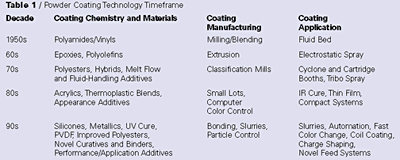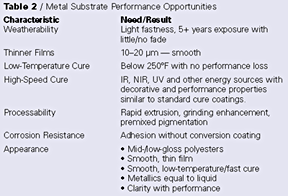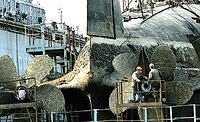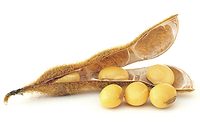Powder Coating Material Development Opportunities to Fuel Growth

Worldwide, nearly $4 billion of powder coating materials are applied annually in industrial operations. They represent 8-9% of industrial finishes, are employed in virtually every metal finishing market segment, and have begun to be used in a variety of plastic, wood, textile, and paper applications. Global annual growth over the last two decades has ranged from 15-20% per year to the current 5-7%.
Despite the rosy past, the future of powder coatings is often questioned. Is the technology mature? Can double-digit growth be achieved again? These questions, while valid, are largely driven by the current U.S economic situation, which, in this author's opinion, is a short-term situation and does not reflect a world view or the impact that technology advancement can have, especially if the advancements lower a finisher's total costs.
One can argue, quite successfully, that powder coatings' robust growth in the past, as well as the future, is directly tied to the technology's offering the lowest cost finishing alternative. The positive environmental aspects of powder use can be linked directly to a user's bottom line. Ease of automated application reclaimability, high throughput/output options, and reduced safety hazards with powder coatings all contribute to the lower finishing cost. In fact, meeting the past challenges of improving material performance with chemistry simply expanded the audience available to take advantage of powder's inherent positive economics.
Table 1 shows the major powder coating materials, manufacturing and application advancements in the decade that they became commercially viable. Please note that the advancements either had a positive economic impact (lower cost powder manufacturing or application) or a performance impact that allowed powder coating economics to enter a new market segment.
While the table is certainly not all-inclusive, it does show a continuum of marketplace-driven developments that often took years to get from initial breakthrough or discovery to commercial success and viability. For instance, the acrylic coatings enjoyed today began development in the late 1960s and early '70s. The hydroxyalkylamide-cured polyester coatings popular in Europe, and growing rapidly in use elsewhere, were first developed/introduced in the '80s. Ultraviolet-cure chemistries available for over a decade are just now finding applications. And again, the success that these and the other powder coating technologies achieved is directly tied to their offering a necessary level of performance at a lower total finishing cost compared to other finishing choices.

The expectation is that developments pertinent to powder coatings for metal will have a quicker route to commercial success and impact than will those for non-metallic substrates. It is also expected that developments will cross over these categories, as formulators have a long history of finding new and novel applications for existing raw material technologies.
Table 2 lists a host of material development challenges, each of which would open new finishing segments to powder coating economics.
Improvements in coating weatherability or resistance to gloss loss from sunlight exposure increase powder's ability to grow in the large North American building products or architectural aluminum market segment. Enhanced weatherability is a key requirement now for automotive finishing, as well as in the agriculture and construction market segments where powder coating is still a minor player.
Routes include developing new hydroxy and carboxy polyester resin and curative systems, as well as additive packages, and perhaps joining silicone and acrylic technologies with each other or with the various polyester systems.
Reduced film thickness reduces cost. Lower cost opens segments for conversion. Challenges here include how to retain package stability and fluid handling properties with a system designed to flow and level extremely well. Again, an opportunity exists for resin and curative system design, for additives to enhance stability and dry flow, for pigment packages that are more easily "wet" by the resin system.
Low-temperature and high-speed cure are linked and impact non-metallic finishing, as well as metal substrate coating. There are differences, however. True low-temperature thermal-cure coatings would allow economical finishing of heavy mass parts, die-cast parts, and pre-assembled equipment. There would not be the need for investment in the process control that radiation cures require. Developments may include plural- component coatings and encapsulated raw materials, as well as new resin-curative systems.

Appearance, or aesthetics, is crucial to coating acceptance and must be part of any cure or weatherability advancements. Appearance development could also increase marketability of existing powder technology. Mid- and low-gloss weatherable powder coating systems are today still difficult to produce from manufacturing consistency, application consistency, or performance points of view. Current resin-curative systems are too temperature- or reaction-rate sensitive; additive packages detract from surface qualities and/or are too cure-temperature sensitive.
A robust low- and mid-gloss weatherable system would find ready acceptance across numerous segments. If it were coupled with improved weatherability, dramatic growth could be possible in the architectural and automotive markets. The finisher would not really care whether the system was polyester, acrylic, silicone, or some simple or complex hybrid.
Though it is unlikely that powder coatings will ever be successfully applied to dirty parts, development of a decorative powder system that did not require a conversion coating could create step out growth opportunity. Chrome and zinc conversion coating use is heavily regulated and iron phosphate regulatory issues are growing. Elimination of this finishing step without sacrificing coating adhesion performance would have major economic impact across all current and future powder-on- metal segments.
Is the answer resin-curative design, additive package, or pigment design? The answer is probably all of the above, working together.
Powder coatings are being used today on MDF and on a few select plastics. The chemistries are mostly thermal or UV cure. Growth on MDF should continue, however, development in two areas is required to provide step-out growth or new market penetration.
The first is melt, flow, and/or cure below 200 deg F. Cure at or below 200 deg F allows powder on virtually any wooden substrate and many plastic ones. The challenge is similar to that for low-temperature coatings for metal. How do we have rapid viscosity reduction, wetting, leveling, and cure at or below 200 deg F while maintaining reactive and dry flow stability at temperatures from 70-120 deg F? Plural-component, dual-cure, UV-cure binder systems, as well as novel powder manufacturing and application systems, are all being investigated and developed.
Along with lower temperature melt, flow and cure, powder coatings will require new, novel adhesion mechanisms for application to plastic substrates. Many high-volume plastic liquid coating operations are now multi-step. Simply replacing one step with powder does not usually provide significant economic conversion justification. The adhesion promoter basecoat operation, as well as the primary color performance coat steps, needs to be a one- or two-step powder application. Again, significant binder system and additive package development is required for success.
The biggest challenge for powder for non-metal substrates is probably not chemistry or manufacturing or application. The challenge is rather the appetite for the investment required for success. This author does expect success here to continue to be driven by work for metal substrates and by the growing technologies now used for MDF finishing as customers (metal OEMs with plastic operations, and MDF users with hardwood operations) exert pull.
Overall, there are numerous other material developments under way that will fuel powder coatings' future: biologically active or resistant powder coatings are early in commercialization, unique pigmentation systems are under way that may increase both speed of color matching and the range of looks available, new thermoplastics are being introduced, novel materials for coating conductivity are under way, and nanotechnology is being explored in all raw material areas.
Keep in mind that finishing - adding protection and decoration to manufactured goods - is not ending, but that finishing systems do end - they are replaced. Powder coatings' positive economics have made it a significant choice for two decades of growth replacing other finishing technologies. The developments currently under way in those areas outlined above should continue the growth, continue the spread of cost-effective powder coating for yet another 20 years.
This article is based on a paper presented at the 2003 International Waterborne, High-Solids, and Powder Coatings Symposium in New Orleans, sponsored by The University of Southern Mississippi School of Polymers and High Performance Materials.
For more information, contact Steven L. Kiefer, Rohm and Haas Powder Coatings, 5 Commerce Drive, Reading, PA 19612.
Looking for a reprint of this article?
From high-res PDFs to custom plaques, order your copy today!





